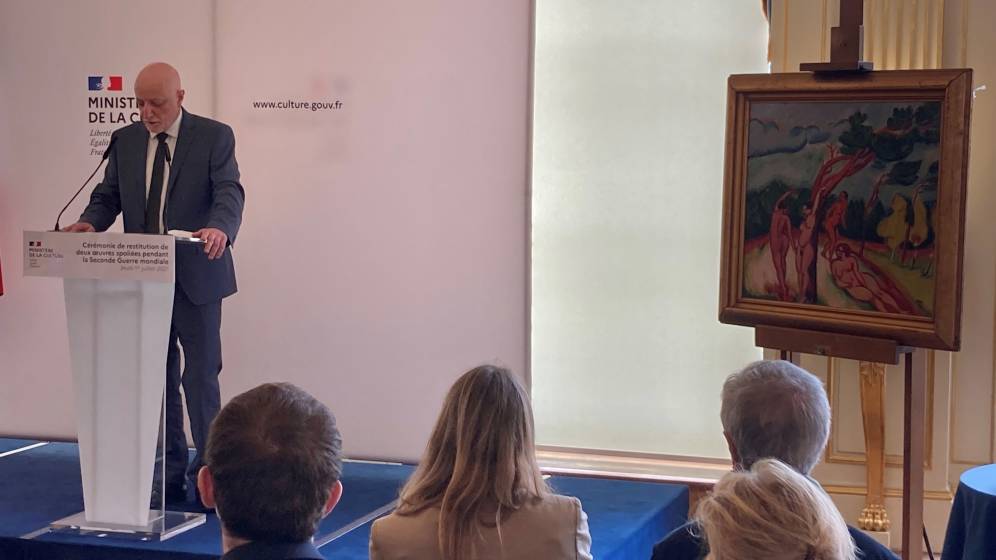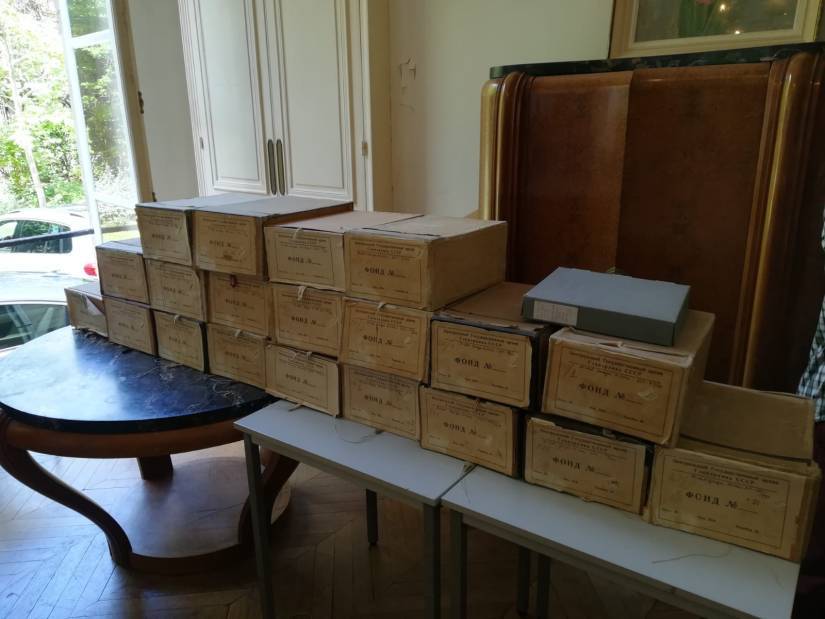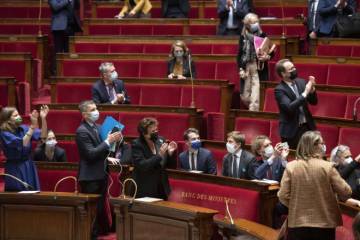Following in the footsteps of a tapestry sold under duress by a Jewish family in 1936, follow three paintings by Fédor Löwenstein stuck in the port of Bordeaux or dive into a collection of literary and personal archives that have crossed Europe to the USSR before returning to France. All these exciting stories – and sometimes with many twists and turns – are told in “Track”, an original podcast designed by the Ministry of Culture, including the six episodes just went online. This podcast is one of the Year of the Documentary 2023, launched last January.
At the origin of this project, the Mission to search for and restore cultural property stolen between 1933 and 1945 (M2RS) of the Ministry of Culture. This mission was created in 2019 to pilot and animate the public policy of research, repair and memory of the spoliations of cultural property. It focuses in particular on individual cases of spoliation by working with the cultural institutions concerned in order to arrive at a remedy (restitution or compensation).
Through six episodes of about twenty minutes directed by Léa Veinstein and narrated by the actress Florence Loiret Caille, the listener retraces the thread of these works stolen from Paris, Bordeaux, Vienna or Munich, whose owners and their successors had to be identified and found. Each episode also reveals the voices of the descendants or representatives of the dispossessed, but also of most of those who participated in the survey: researchers of origin, representatives of the museums that kept the works… Feedback on this atypical and exciting project with David Zivie, Head of the Mission for the Search and Restitution of Cultural Property Looted between 1933 and 1945, and Elsa Vernier-Lopin, research fellow in this mission.
You just launched a series of six podcasts about stolen works whose origin has been traced. Why did you choose this medium?
Elsa Vernier-Lopin: We started talking about this podcast shortly after the creation of the mission, one of whose objectives is to raise awareness of issues of spoliation. The podcast is a medium that has gained great visibility in recent years, quite simple to set up, and that allows to address the greatest number because of its free.
We already have a specific technical space on the website of the Ministry of Culture, and we wanted to find a way to talk about our subjects in a more accessible way for the general public. Plunder is multiple and some stories, often complex, can be difficult to explain. This podcast allows us to be quite concrete and educational: these are real stories, real works, that concern real families. The voice, and more generally the sound, allow to testify in a more incarnate way than the written.
We also wanted to have the time, space and control of our content with a double stake: to be as precise as possible so as not to make an approximation while remaining accessible through history. The episodes also allow to hear the voices of the different actors because the mission does not work alone but in network with museums, researchers, families...
David Zivie: We wanted to present this collective work while telling these hard, tragic, complicated, sometimes incredible stories, but always very strong. We are involved in the six episodes: some files started before the creation of the mission, which shows the necessarily long time of this research, others not, but all ended after 2019.
How did you choose the six works or groups of works? Have you ensured that the files you deal with on a daily basis are representative?
E.V.-L: We have indeed chosen cases that show the diversity of works. Four of the six episodes concern paintings. In fact, they represent the majority of our work: they are works better referenced in sales catalogues and whose descriptions are simpler. But we also wanted to show the diversity of our approach with two other episodes, one on a tapestry and the other on personal archives.
D.Z. : We wanted to vary the interlocutors, the institutions that have preserved these works, such as the Musée d'Orsay, the Louvre, the National Museum of Modern Art, but also a museum in the region, the Labenche Museum of Brive-la-Gaillarde, and archives kept in a historical associative actor, the Société des Gens de Lettres. It is the same principle that governed the choice of places of spoliation (Paris, Bordeaux, Germany, Austria) and types of spoliation (looting, selling under duress...).
The relationship with the rights holders also called for different treatments. In some cases, the request for research came directly from them and in others, it came from a proactive approach on the part of the department. For the Javal family, forty-seven rights holders were found thanks to the help of the Genealogists of France: the State went to meet them while they themselves had not taken any steps.
E.V.-L: Finally, it was necessary to find almost as many solutions as there are restitutions: it took a law to return the work of Klimt to its rightful beneficiaries, an agreement between the museum of Brive-la-Gaillarde and the family so that the tapestry Smell The Mortlake Factory can stay in the museum…
We wanted to find
a way to speak
of our subjects
more accessible
To produce this series of podcasts, it took a personality who had a real appetite for memory issues like Léa Veinstein…
E.V.-L: The trigger was his exhibition curator “The voice of witnesses” at the Shoah Memorial and its podcast on the evolution of testimonies around this period. His work on memory and transmission resonated strongly with our questioning. She has a very different professional look than ours, which allowed us to make the podcast accessible to the general public.
His work seduced us because, more than the subject of the Second World War, it was the question of memory that interested us. Works of art are witnesses of history. For example, in one episode, we hear Rose Valland (Conservation Officer at the Jeu de Paume Museum, which played a decisive role in collecting a great deal of information on works of art and objects stolen by the Nazis during the Occupation editor’s note). It is a very powerful moment to hear the voice of this essential woman.
Has the awareness of these spoliation issues been felt since the creation of the mission in 2019?
D.Z. : There is an evolution, an advance in the awareness of museums, particularly territorial museums that are wondering about the origin of their collections. For example, we receive more and more questions when acquiring a work whose origin is unclear. Research that has not been done in previous acquisitions has been launched in some major national museums such as the Louvre, the Musée d'Orsay and the Musée national d'art moderne. A museum is opening a research station specifically on these issues, which did not exist a few years ago. We also see, on the art market, a growing concern of the various actors, so that stolen works are not sold.
More and more public actors are interested in this issue with training for students and professionals at the National Heritage Institute or the Ecole du Louvre or in masters in law or devoted to the professions of culture. We see more and more museums interested in mediation and the presentation of these works to the public: opening of a specific room, a page on their website, particular visit path…
E.V.-L: We are also a more identified interlocutor and we set up a methodology with the provision of specific cartels, indications of mediation but also tools of provenance search. And so – on the value side – this podcast series.
A mission to amplify research on stolen works of art
Nearly 100,000 works or works of art and between 5 and 10 million pounds: the estimated heritage of cultural property stolen in France is considerable. « It is probably underestimated, since these figures are based on post-war statements by victims, which are not exhaustive '' said David Zivie. To better identify these properties and trace their history, the mission to search for and return cultural property stolen between 1933 and 1945 (M2RS) was created in 2019 within the General Secretariat of the Ministry of Culture. Its objective: to pursue, extend and amplify the policy of reparation and spoliation by developing the research component on cultural works. She works in particular, within the Ministry, with the Service des musées de France and the Service du livre et de la lecture, and, beyond that, with the CIVS (Commission for Compensation of Victims of Plunder) , attached to the Prime Minister, who recommends reparations for antisemitic plunder compensation or restitution.
The M2RS has several missions. First of all, to coordinate, mobilize and sensitize scientific teams in museums and libraries and the art market on these issues of plunder. It then conducts the study and research on a case-by-case basis on missing stolen works or on works of dubious origin preserved in public institutions, either at the request of families, or on its own initiative or that of museums and libraries. She works in particular, with museums, on the works said MNR (National Museums Recovery) – just under 2,000 in more than a hundred museums in France – found in Germany after the war and sent back to France, some of which were looted. Finally, it encourages and supports research on works that have entered the public collections since 1933, whose provenance remains uncertain.
Partager la page





